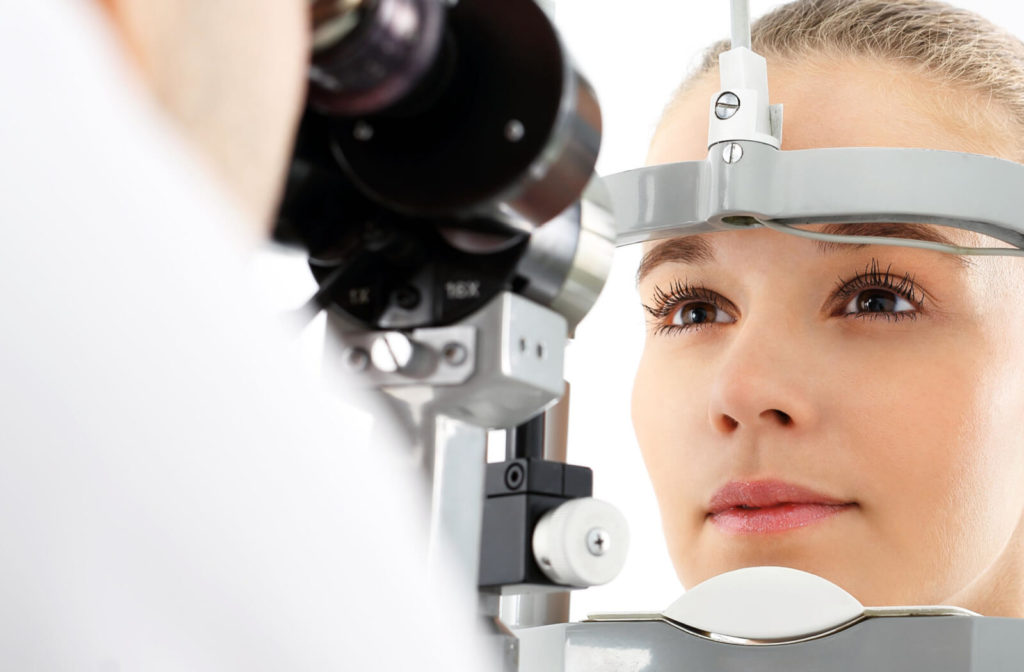A refraction eye exam is a vision test designed to detect refractive errors and is a standard part of regular comprehensive eye exams.
Refraction refers to how light bends when it enters the eye. A refractive error occurs when light doesn’t bend correctly, so it doesn’t focus on the retina (the light-sensitive tissue at the back of the eye), resulting in blurry vision and other symptoms. There are several refractive errors:
- Myopia (nearsightedness)
- Hyperopia (farsightedness)
- Astigmatism
- Presbyopia
In this blog, we discuss why refraction eye exams are necessary, how they detect eye problems, and how often you should have one done.
What Is a Refractive Eye Exam?
A refraction or vision test determines whether you need vision correction and the prescription power you need for eyeglasses or contact lenses to see clearly. This test measures how light bends when it enters your eyes.
The cornea (the transparent dome over your eye) and lens (the clear sphere that sits behind the pupil) work together to refract (bend) light to focus on your retina. If something prevents light from focusing correctly, you won’t be able to see clearly.
Causes of various refractive errors can include:
- A too-short or too-long eye
- A thick or thin lens
- An aging lens
- A change in eye shape
- Irregular cornea shape
When light focuses in front or behind the retina, you can experience blurry vision with objects close-up or farther away. Your eye doctor may use a machine to measure the amount of light reflected by the retina to determine your refractive score, which helps calculate your prescription.
If your optometrist has detected a refractive error, the next step is determining which individual lenses can help you see using a phoropter. As you look at letters on a wall 20 feet away, your eye doctor will change between lenses of varying strengths to see which provides the sharpest vision. Think of when your optometrist asks: “which is better: 1 or 2?”
What Does a Refractive Eye Exam Diagnose?
4 types of refractive errors can be detected during a refraction eye exam.
Nearsightedness or Myopia
Myopia occurs when you can see close-up objects clearly, but far-away ones look blurry. It’s caused by an eye that’s too long or a cornea that’s too steep, resulting in light focusing on a spot in front of the retina.
Straining to see distant objects can cause blurry vision, eye strain, and headaches.
Farsightedness or Hyperopia
Hyperopia occurs when you can see objects at a distance but nearby ones look blurry. It’s caused by an eye that’s too short or a cornea that’s too flat, resulting in light focusing on a spot behind the retina.
Common symptoms are blurry vision, eye strain and fatigue, and headaches.
Astigmatism
Astigmatism occurs when an abnormal cornea or lens shape blurs or distorts your vision at all distances.
Light reflects differently in an eye with astigmatism because the cornea is a football or oval shape instead of round. Common symptoms include double vision, eye strain, headaches, and poor night vision.
Presbyopia
Presbyopia is a natural part of the aging process and eventually affects everyone. It’s why so many people require reading glasses as they age.
The eye’s lens changes shape to focus light and requires flexibility to do this. Presbyopia occurs when the lens becomes rigid and less flexible over time. As the lens loses elasticity and hardens, light isn’t focused correctly on the retina.
Common symptoms include eye strain, headaches, and difficulty seeing images close-up or while reading.
How Often Should You Have a Refractive Eye Exam?
The American Optometric Association recommends that:
- Adults between 18 and 64 have an eye exam every 2 years (or annually if recommended)
- Adults 65 and older have an eye exam every year (or more if recommended)
- Children have their first eye exam between 6 and 12 months
- Children between 3 and 5 years have an eye exam at least once before school
- Children between 6 and 17 years have an eye exam every year (or more if recommended)
You’re at a higher risk for developing refractive errors if you have a family member who needs prescription glasses or contact lenses. If you experience blurry vision, headaches, or poor vision, you should schedule a refraction eye exam with your eye doctor.
Prescription Lenses for Clearer Vision
Regular eye exams with refraction testing ensure vision problems are detected early, prescriptions remain up-to-date, and timely solutions are recommended for myopia control.If you experience symptoms or notice changes in your vision, don’t delay. Contact us or book an exam with Total Vision Tierrasanta, and let us help to preserve your vision.


